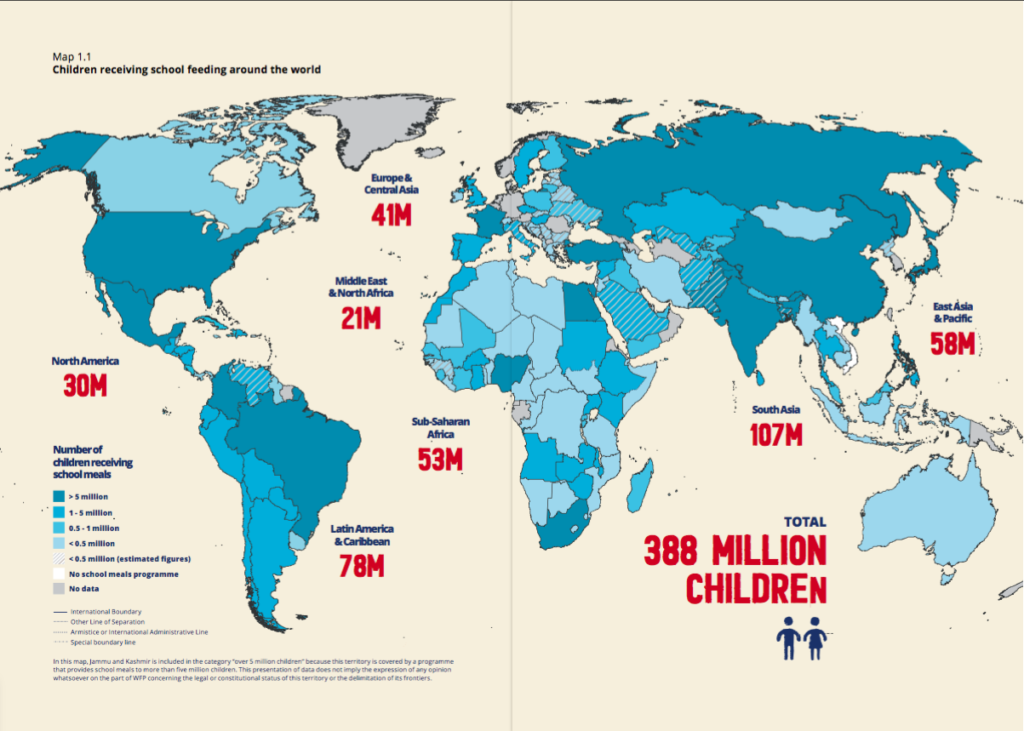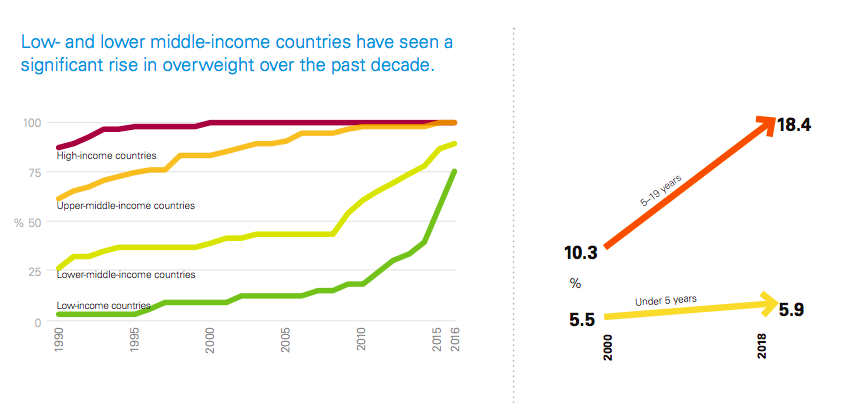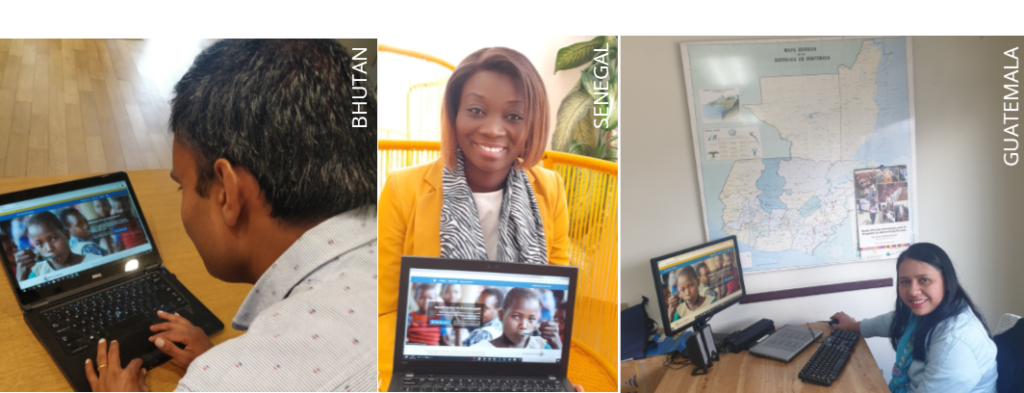The COVID-19 pandemic has undoubtedly disrupted the lives of children through school closures, interrupted education, and limits to social interaction. According to the 2020 ‘State of School Feeding Worldwide’ (SOSFW) report, school closures truly emphasised how crucial school meal programmes are to millions of children; while also illuminating the cracks in school procurement systems and their ability to adapt. With 2020 behind us there is hope that 2021 will bring change and provide more opportunities. The United Nations Food Systems Summit is an opportunity to rebuild our food systems to become more sustainable, equitable and nutritious. Action Track 1 of the Food Systems Summit – ‘Ensuring access to safe and nutritious food for all’ – aims to progress towards ending hunger and guaranteeing access to safe and nutritious food for everyone. Child nutrition is inevitably a central focus of this action track; opening the door to innovations and investments in school meal programmes with the potential to influence the future of millions of children.
The Importance of School Meals
Millions of children around the world eat at least one meal at school every school day, as shown in the map below from the SOSFW (2020) report. This report from the World Food Programme outlines that school meal programmes are essential for supporting mental and physical development in the first 8,000 days of a child’s life. Despite the importance of school meals to nutrition and development, the 2019 ‘State of the World’s Children’ (SOWC) report reveals that the overconsumption of convenient and low cost processed food, including in school environments, has increased the prevalence of overweight in school age children and teenagers. Figure 2 shows that prevalence has increased faster in low and low-middle income countries.


The SOSFW (2020) report shows that every $1 investment in nutritious school meals can provide economic returns of $9 in health systems, social protection systems and local agricultural systems. Despite this, some governments are still reluctant to invest in good quality and nutritious school meal programmes and this is likely to be exacerbated by COVID-19 related cuts (SOSFW, 2020). Even in the UK, one of the richest countries in the world, child nutrition is still not fully recognised as a worthwhile investment. This is reflected in recent criticism towards the UK government for providing inadequate food packages to children in England during lockdown in replacement of the ‘free school meal’ programme. Below is an example food parcel, equating to around £5 and expected to feed a child for 10 days.
Locally Sourced School Meals
Reading the SOWC (2019) and the SOSFW (2020) reports, it is apparent that schools should provide healthy and unprocessed food to promote healthy diets and foster development and learning. Choosing to source local food should also be adopted by more procurement systems, as recommended by the SOSFW (2020) report. The report states that buying and serving local produce promotes sustainable and nutritious food that can shape the preferences of children, while also supporting local producers and reducing supply chain length. This is becoming a popular procurement approach in countries such as Brazil and India, however other countries, especially low income countries, are yet to adopt this approach (SOSFW, 2020). The SOSFW (2020) report broadly recommends that cheap, nutritious and sustainable school meal procurement plans must be established around the world as part of the recovery from the COVID-19 pandemic; although putting this into wide scale practice is complicated.
‘PLUS School Menus’ as a Solution to School Menu Procurement
The World Food Programme’s ‘PLUS School Menus’ is a software used to easily create school meal menus that source food from local producers, keep costs low, match nutritional requirements for children and are regionally appropriate (de Inestrillas et al., 2020). De Inestrillas et al (2020) provided an overview of the process involved in creating school menus using the ‘PLUS School Menus’ software:
- Firstly, the client enters information. This includes where they are situated, what season it is, what prices food products are, what ages the meals are targeted to, how many meals are required, what percentage of daily nutrient intake the meal is aiming to provide, and what percentage of food should be locally sourced.
- Next, an algorithm uses this information to determine an optimal school menu for a duration up to four weeks. The output also displays prices, nutrient content and where the ingredients are sourced.
To improve nutritional content of meals and decrease reliance on imported food, Bhutan became a pilot for the ‘PLUS School Menus’ software with a case study presented by de Inestrillas et al (2020). Through implementation of ‘PLUS School Menus’, the creation of nutritious menus was not only quick and easy but also 20% less expensive. Locally sourced ingredients for the menus increased by 70%, therefore reducing dependence on imports and supporting the local economies. It is also highlighted that the software is easy to use, requires minimal training, and respects local cultures and cuisines. This successful pilot programme has demonstrated the potential of ‘PLUS School Menus’ to deliver improvements to school menus without establishing a ‘one size fits all’ approach. The software is currently undergoing establishment in other regions in extended pilot projects (Figure 3), and is undergoing further development to broaden the choice of recipes, including traditional ones (de Inestrillas et al., 2020).

The Future
Although school meal programmes have reached more children in the past decade, there are still up to 73 million children who cannot access school meals due to financial constraints (SOSFW, 2020). The evidence above from de Inestrillas et al (2020) shows that scaling up ‘PLUS School Menus’ worldwide during the COVID-19 recovery has the potential to cut costs associated with school menus to help reach millions more children; as well as revolutionise school meal procurement to foster healthy lifestyles, sustainable school environments and bustling local economies. This innovation should be presented and discussed further at the Food Systems Summit in relation to the goals of Action Track 1, providing a platform for implementation around the world.
References
de Inestrillas, R.S., Kauffmann, D., Piccini, S., Mastro, C.D. and Momcilovic, P., (2020). PLUS School Menus: the future of school menu design. UNSCN News, 45, 75-82.
UN Food Systems Summit. Available at: https://www.un.org/en/food-systems-summit. Last accessed 28/02/21.
UNICEF. (2019). The State of the World’s Children 2019. Children, Food and Nutrition: Growing well in a changing world. UNICEF, New York.
WFP. (2020). State of School Feeding Worldwide 2020. Rome.
WFP. (2020). PLUS School Menus: Optimizing menus in school feeding services. Available at: https://innovation.wfp.org/project/plus-school-menus. Last accessed 28/02/21.